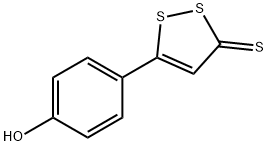| Identification | Back Directory | [Name]
desmethylanethol trithione | [CAS]
18274-81-2 | [Synonyms]
ACS 1
Adt-Oh
Anethole impurity 2
desmethylanethol trithione
Anethole Trithione impurity 2
5-(4-hydroxyphenyl)dithiole-3-thione
5-(4-hydroxyphenyl)-3H-1,2-dithiole-3-thione
3H-1,2-Dithiole-3-thione, 5-(4-hydroxyphenyl)- | [Molecular Formula]
C9H6OS3 | [MDL Number]
MFCD20922704 | [MOL File]
18274-81-2.mol | [Molecular Weight]
226.34 |
| Chemical Properties | Back Directory | [Melting point ]
191-192 °C | [Boiling point ]
431.4±55.0 °C(Predicted) | [density ]
1.56±0.1 g/cm3(Predicted) | [storage temp. ]
Inert atmosphere,2-8°C | [solubility ]
DMF: 15 mg/ml; DMF:PBS (pH 7.2) (1:1): 0.5 mg/ml; DMSO: 5 mg/ml; Ethanol: 1 mg/ml | [form ]
A crystalline solid | [pka]
9.78±0.30(Predicted) | [color ]
Yellow to brown |
| Hazard Information | Back Directory | [Description]
ADT-OH is a derivative of anethole dithiolethione (ADT) and synthetic hydrogen sulfide (H2S) donor. It can be readily esterified with other moieties.1 For example, it can be coupled with therapeutics like nonsteroidal anti-inflammatory drugs, as in the generation of ATB-343 (Item No. 13045).2 ADT-OH has also been linked with a mitochondria-targeting motif to produce AP-39 (Item No. 17100), which selectively increases mitochondrial H2S levels.3 ADT-OH is used both in cells and in animals for comparative studies with derived chimeras.3,4 | [Uses]
is used in method for preventing or treating diseases associated with administration of VEGFR and/or VEGF inhibitor. | [Synthesis]
The general procedure for the synthesis of 5-(4-hydroxyphenyl)-3H-1,2-dithio-3-thione from anethole was as follows: anethole (1) (32.5 g, 0.21 mol) was mixed with sulfur powder (45 g, 1.40 mol) in N,N-dimethylformamide (250 mL) and the reaction was carried out by heating and refluxing for 8 hours. After completion of the reaction, the solvent was removed by distillation under reduced pressure and the resulting residue was dissolved in toluene. Subsequently, the toluene solution was extracted with 2N aqueous sodium hydroxide solution to give an orange solid precipitate (8.5 g). The solid product was dissolved in boiling water and hydrochloric acid was added slowly to acidity to precipitate an orange precipitate (2) in 50% yield with a melting point of 205 °C (literature value 188-189 °C). The structure of the product was confirmed by 1H NMR (DMSO-d6) and mass spectrometry (ESI): 1H NMR (DMSO-d6) δ 6.86 (d, 2H), 7.68 (s, 1H), 7.75 (d, 2H), 10.51 (s, 1H, -OH); MS (ESI) m/z 225 [M-H]-. | [in vivo]
ADT-OH (10-30 mg/kg, i.p., every day) reveals a potent anti-metastatic activity in three different mice models, the MDA-MB-231 orthotopic xenograft model, the 4T1-Luci orthotopic model and the 4T1-Luci tail vein metastasis model[2].
| Animal Model: | MDA-MB-231 orthotopic xenograft model, the 4T1-Luci orthotopic model and the 4T1-Luci tail vein metastasis model[2] | | Dosage: | 10, 20, 30 mg/kg | | Administration: | Intraperitoneal injection (i.p.) | | Result: | Had limited effect on the growth of primary tumors, but could significantly suppress the metastasis of MDA-MB-231 tumors.
Had no significant effect on body weight of mice.
|
| [References]
[1] Patent: US2006/270635, 2006, A1. Location in patent: Page/Page column 12; 16-17
[2] Patent: WO2006/125293, 2006, A1. Location in patent: Page/Page column 36-37; 47
[3] Patent: WO2006/125295, 2006, A1. Location in patent: Page/Page column 40-41; 51
[4] Patent: US2008/4245, 2008, A1. Location in patent: Page/Page column 10 |
|
|







